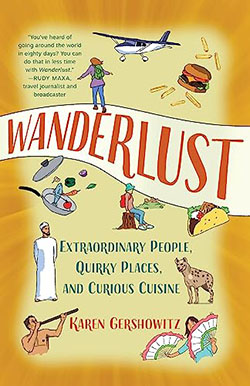Wanderlust: Extraordinary People, Quirky Places, and Curious Cuisine by Karen Gershowitz; She Writes Press; ISBN 9781647-525586; 296 pages plus $17.95.

 SAN DIEGO – Travel writers often have different approaches. When I travel, I always want to dig up the “Jewish story,” a predilection that has me researching months in advance of my trips and setting up interviews with experts whom I will meet at the destinations. Karen Gershowitz takes a more relaxed, serendipitous approach. She wants to taste the local culture, enjoy new experiences, and see where the adventures take her. Obviously, her approach will attract more readership among the general population.
SAN DIEGO – Travel writers often have different approaches. When I travel, I always want to dig up the “Jewish story,” a predilection that has me researching months in advance of my trips and setting up interviews with experts whom I will meet at the destinations. Karen Gershowitz takes a more relaxed, serendipitous approach. She wants to taste the local culture, enjoy new experiences, and see where the adventures take her. Obviously, her approach will attract more readership among the general population.
Gershowitz is an inveterate traveler, as is demonstrated by her descriptions of more than three dozen adventures around the globe in a great variety of environments: deserts, jungles, glaciers, and farming villages, to name a few. She grew up in New York City, where she delighted in sampling ethnic restaurants and visiting museums that provided a window into the way other people lived.
An artist and ceramicist who later went into marketing, she revels in opportunities to see the techniques employed by artists in other countries. She also loves to sample new foods, particularly fish. Her descriptions are mouth-watering of the sushi and salmon roe available in Japan’s northernmost island of Hokkaido.
Her Jewish background enters occasionally into her travel writing. In Switzerland, eating roti reminded her of the latkes traditionally served at Chanukah. In Malaysia, the story of her Chinese guide’s family and heritage prompted recollections of her own family’s immigration story. “Our geography and ethnicities were different, but our grandparents’ motivations were the same, a better life for themselves and their children.” In the Czech Republic, she toured Prague’s old Jewish quarter, noting in passing that the 13th century Altneushul (Old-New Synagogue) “was one of the few synagogues to survive the Nazis.” In Austria, seeing older people unsettled her. “I couldn’t get it out of my head that they might have been Nazis or Nazi sympathizers.”
She felt more exposed as a Jew in Europe than she did in the Arab Middle East. Separate chapters about Fez, Morocco, focused on bargaining, with tea drinking, and her encounter with a gay man who had converted to Islam, hoping to find acceptance among Morocco’s more tolerant practitioners. Nary a word about Israel nor the continuing Arab-Israeli dispute, even though both of these trips came well before Morocco and Israel established formal diplomatic relations.
I’m not saying that Gershowitz was wrong in her approach, just different; she covered the aspects of Morocco that attracted her interest. Obviously, I would have gravitated toward a different kind of story, different but not better. In the United Arab Emirates, Gershowitz wrote about the opulence of the buildings and her experience picking out fish at a market, then having it gutted and cooked for her right on the premises.
My favorite story, among the many, was her description of an overnight visit to a Chinese farming village about 90 minutes travel from Xi’an. First, she went to an elementary school in which kids went to and from recess as Strauss waltzes played over loudspeakers. At an art class, children drew lotus flowers. Invited to join in, Gershowitz, a trained artist, drew one too, winning admiration and applause from the students. Next, she went to the two-story apartment of Mrs. Jong, who didn’t speak English. However, the Chinese government prepared some pages containing Chinese phrases and equivalent English phrases. To communicate, Gershowitz could find a numbered English phrase, and point to the number. Then Ms. Jang would find the same number on her sheet to understand the comment. While this permitted only limited conversation, the two women were able to exchange courtesies. No translations were necessary for Jang to give a cooking demonstration, nor for Gershowitz to join townspeople in a folk dance.
It was during the COVID pandemic, when Gershowitz confined herself to outdoor walks with her mask on or solo drives around the city, that she had the opportunity to reflect on travel’s meaning to her. “Deep within me burns an insatiable hunger to see and try new things,” she wrote. “When I board a plane to somewhere I’ve never been to before, I am guaranteed that all my senses will be engaged with new sensations. It’s impossible to know exactly what will happen, who I’ll strike up a conversation with, what I’ll learn, what trouble I’ll get into.”
Furthermore, she reported, “I travel because I like to shake up my routine. A college professor taught me years ago that experimentation with different ways of doing things and breaking routines is exercise for the brain. It makes people more alert, healthier, and helps stave off Alzheimer’s disease. I figure reading a map and navigating a new city, deciphering a menu in another language, and seeing new plants and animals helps to keep my brain young. And it’s a lot more entertaining than trying to write or brush my teeth with my left hand.”
Although different from mine, her style is an important perspective on travel. I’m glad that I read Gershowitz’s memoir. I think you will be too.
*
Donald H. Harrison is editor emeritus of San Diego Jewish World. He may be contacted via donald.harrison@sdjewiswhorld.com